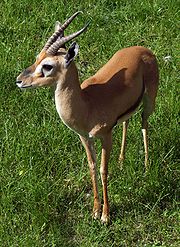
Eudorcas
Encyclopedia
Eudorcas is a genus of antelope. The species within the genus Eudorcas are often called gazelles. Eudorcas was originally considered a subgenus within the genus Gazella
but has since been elevated to genus status. There are four species within the genus Eudorcas, one of which is extinct:
 The social structure of gazelles consists of several types of groups. Male gazelles are territorial throughout their adult lives, though not usually before 2–3 years of age. During the non-territorial periods males usually spend their time in bachelor groups or as part of a mixed herd. Likewise females will form migratory female groups that travel through the males' territory. As the female groups pass through, the territorial males will try to herd them to prevent them from leaving. Adult male bucks with adjoining territories will engage in combat several times a day, fighting with their horns to establish dominance and the boundaries of their territories. In this way, the accepted boundaries of the territory can change on a daily basis. If a lone male, a bachelor group, or in some cases even an adolescent male fawn of a female gazelle should be passing through a territorial male's region, the male will chase the offender out of his territory. Interestingly, this territoriality does not extend to males of other species.
The social structure of gazelles consists of several types of groups. Male gazelles are territorial throughout their adult lives, though not usually before 2–3 years of age. During the non-territorial periods males usually spend their time in bachelor groups or as part of a mixed herd. Likewise females will form migratory female groups that travel through the males' territory. As the female groups pass through, the territorial males will try to herd them to prevent them from leaving. Adult male bucks with adjoining territories will engage in combat several times a day, fighting with their horns to establish dominance and the boundaries of their territories. In this way, the accepted boundaries of the territory can change on a daily basis. If a lone male, a bachelor group, or in some cases even an adolescent male fawn of a female gazelle should be passing through a territorial male's region, the male will chase the offender out of his territory. Interestingly, this territoriality does not extend to males of other species.
The territory of a Thomson's gazelle and several other types of ungulates may overlap with no problem whatsoever. Occasionally, a Thomson's gazelle and a zebra or other ungulate will even appear to enjoy one another's company with great sociability. A noticeable behaviour of Thomson's gazelles is their bounding leap, known as stotting
or pronking, used to startle predators and display strength. Female Thomson's gazelles give birth to single fawns after a 5–6 month gestation period. They are unusual among ungulates in that they can give birth twice yearly, rather than just once. Fawns spend the first few months hiding in the grasses with the mother coming to feed it daily. When the fawn can take care of itself, it joins the herd. Half of all the fawns born will be lost to predators before reaching adulthood.
Gazelle
A gazelle is any of many antelope species in the genus Gazella, or formerly considered to belong to it. Six species are included in two genera, Eudorcas and Nanger, which were formerly considered subgenera...
but has since been elevated to genus status. There are four species within the genus Eudorcas, one of which is extinct:
- Genus Eudorcas
- Mongalla GazelleMongalla GazelleThe Mongalla Gazelle is a species of gazelle found in the floodplain and savanna of southeastern Sudan. It was formerly treated as a subspecies of the well-known Thomson's Gazelle...
, E. albonotata - Thomson's GazelleThomson's GazelleThe Thomson's gazelle is one of the best-known gazelles. It is named after explorer Joseph Thomson and, as a result, is sometimes referred to as a "tommie"...
, E. thomsoni - Red-fronted GazelleRed-fronted GazelleThe Red-fronted gazelle is a species of gazelle that is widely but unevenly distributed across the middle Africa from Senegal to north-eastern Ethiopia. It is mainly resident in the Sahel zone, a narrow cross-Africa band south of the Sahara, where it prefers arid grasslands, wooded savannas and...
, E. rufifrons - Red GazelleRed GazelleThe red gazelle was thought to be an extinct species of gazelle. It was formerly considered a member of the genus Gazella within the subgenus Eudorcas before Eudorcas was promoted to a full genus...
, E. rufina (Extinct)
- Mongalla Gazelle
Social structure and behavior

The territory of a Thomson's gazelle and several other types of ungulates may overlap with no problem whatsoever. Occasionally, a Thomson's gazelle and a zebra or other ungulate will even appear to enjoy one another's company with great sociability. A noticeable behaviour of Thomson's gazelles is their bounding leap, known as stotting
Stotting
Stotting is a gait of quadrupeds, particularly gazelles , involving jumping high into the air by lifting all four feet off the ground simultaneously. This may occur during pursuit by a predator...
or pronking, used to startle predators and display strength. Female Thomson's gazelles give birth to single fawns after a 5–6 month gestation period. They are unusual among ungulates in that they can give birth twice yearly, rather than just once. Fawns spend the first few months hiding in the grasses with the mother coming to feed it daily. When the fawn can take care of itself, it joins the herd. Half of all the fawns born will be lost to predators before reaching adulthood.

